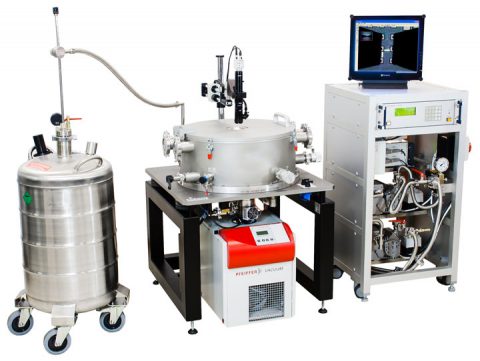
September 13, 2018
FormFactor designed a unique vacuum and cryogenic wafer-level probe system, available as laboratory, manual or semi-automated probe systems for testing wafers and substrates up to 300 mm.

September 13, 2018
FormFactor designed a unique vacuum and cryogenic wafer-level probe system, available as laboratory, manual or semi-automated probe systems for testing wafers and substrates up to 300 mm.
As semiconductor devices continue to get smaller and smaller and new materials are introduced, the characteristics of these devices cannot be completely explained using current theory. As such, much of the research being conducted involved testing these new elements – high electron mobility transistors (HEMT), infrared focal plane arrays, and superconductors – at cryogenic temperatures.
Building off of the experience from its atmospheric probe systems, FormFactor has designed unique vacuum and cryogenic wafer-level probe systems available for laboratory-scale, manual or semi-automated testing of wafers and substrates up to 300 mm. The PLC50 probe system is the most cost-effective and simple, yet highly-precise probing solution for wafers and substrates up to 100 mm at cryogenic temperatures. Specifically designed for laboratory requirements, it supports a wide range of applications, including I-V, C-V and RF, and can be used for probing down to 77 K with liquid nitrogen or 7 K with liquid helium. Application flexibility is ensured for DC and RF measurements of the latest silicon, compound semiconductor and superconductor devices. RF tests are supported by a wide range of probes, calibration substrates and other accessories, as well as WinCal XE™ calibration software. The unique LRRM, LRM+, NIST-style TRL and hybrid calibration methods are available with the WinCal wafer-level calibration and measurement software.
The PLC50 is equipped with a stable vibration isolating frame. The high-vacuum chamber with a hinged topside lid and an optical window made of quartz glass (or other optical materials based on configuration needs) contains flanges for vacuum-tight mechanical feedthrough drives. Thus, the chuck and up to six vacuum-type positioners can be easily operated from outside via cardanic shafts. Placing the positioner inside the chamber guarantees a precise probe landing with short and stable probe arms. The high-vacuum pumping system consists of a Turbo-Molecular Pump (TMP), a diaphragm forepump, and a full-range vacuum gauge.
The vacuum chamber houses the chuck stage, which can extend up to 80 x 80 mm linearly. The probe platen is designed to mount up to six vacuum-type positioners on magnetic feet. For step-and-repeat contacting capability, the probe platen can be lifted up and down from outside the chamber by a unique mechanical drive. A high-resolution video microscope is mounted above the view-port.
The cryogenic chuck is surrounded by a cryogenic shield. It prevents background radiation getting to the device under test. This shield can be cooled independently from chuck. It allows cooling down the shield prior to the chuck to capture residual gases inside the chamber. This ensures ice- and condensation-free probing.
The PLC50 probe system can be customized with a number of instruments, including various video microscopes, and optical analysis of structural motion and surface topology measurement tools.
For additional features, benefits, and specifications download the complete product data sheet for PLC50 (PDF).
For non-cryogenic test requirements (e.g. for MEMS applications), the PLV50 vacuum probe system is available with an optional thermal chuck that supports a wide temperature range from -60°C to 300°Cand a vacuum level down to less than 10-5 mbar.